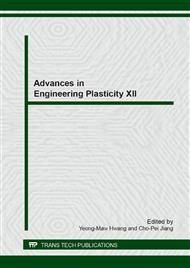[1]
M. G. Cockcroft, D. J. Latham, A simple criterion of fracture for ductile metals, National Engineering Laboratory, (1966)
Google Scholar
[2]
D. M. Norris, J. E. Reaugh, B. Moran, D. F. Quinones, A plastic-strain, mean stress criterion for ductile fracture, Journal of Engineering Materials and Technology 100 (1978), 279-286.
DOI: 10.1115/1.3443491
Google Scholar
[3]
M. Oyane, T. Sato, K. Okimoto, S. Shima, Criteria for ductile fracture and their applications, Journal of Mechanical Working Technology 4(1)(1980), 65-81.
DOI: 10.1016/0378-3804(80)90006-6
Google Scholar
[4]
A. G. Atkins, Possible explanation for unexpected departures in hydrostatic tension-fracture strain relations, Metal Science 15(1981), 81-83.
DOI: 10.1179/msc.1981.15.2.81
Google Scholar
[5]
W. L. Zhuang, Finite element simulation for predicting the forming limit of sheet metals, Master Thesis, Department of mechanical engineering, National Cheng Kung University, Taiwan. (1990)
Google Scholar
[6]
C. F. Lin, Energy criterion establishment by finite element method and the simulation of strain paths, Master Thesis, Department of mechanical engineering, National Cheng Kung University, Taiwan. (1991)
Google Scholar
[7]
H. Y. Chiu, Formability analysis of HA-188 cobalt-base superalloy in tube hydroforming, Master Thesis, Department of mechanical engineering, National Cheng Kung University, Taiwan. (2011)
Google Scholar
[8]
C. H. Chen, R. S. Lee, J. T. Gau, Size effect and forming-limit strain prediction for microscale sheet metal forming of stainless steel 304, The Journal of Strain Analysis for Engineering Design, 45.4(2010), 283-299.
DOI: 10.1243/03093247jsa585
Google Scholar
[9]
R. S. Lee, Y. K. Lin, Y. J.Chen, T. W.Chien, Determination of the forming limit curve of high strength steel sheet based on fracture criterion, Chinese Mechanical Engineering Society Symposium, 29 (2012) no. 1439.
Google Scholar
[10]
P. F. Bariani, S. Bruschi, A. Ghiotti, A. Turetta, Testing formability in the hot stamping of HSS. CIRP Annals-Manufacturing Technology, 57(1) (2008), 265-268.
DOI: 10.1016/j.cirp.2008.03.049
Google Scholar
[11]
J. Min, J. Lin, J. Li, W. Bao, Investigation on hot forming limits of high strength steel 22MnB5. Computational Materials Science, 49(2) (2010), 326-332.
DOI: 10.1016/j.commatsci.2010.05.018
Google Scholar
[12]
R. S. Lee, H. Y.Chiu, Y. J.Chen, Y. C.Lo, C. C.Wang, Evaluation of Facture Criteria Considering Complex Loading Paths in Cobalt Alloy Tube Hydroforming, Materials Transactions 53.5 (2012), 807-811.
DOI: 10.2320/matertrans.mf201119
Google Scholar
[13]
R. S. Lee, T. W. Chien, A New Method for Testing Formability in Sheet Metal Forming at Biaxial Tensile State, Asia-Pacific Conference on Engineering Plasticity and Its Applications, AEPA 2014 (to appear).
DOI: 10.4028/www.scientific.net/kem.626.275
Google Scholar


